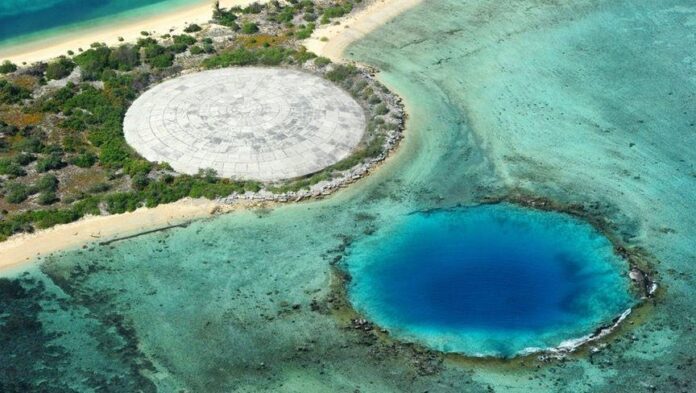A group of fifteen artists including Lisa Reihana, who represented New Zealand at the 2017 Venice Biennale, form part of a 30-strong assemble setting sail this week for the Marshall Islands in the Pacific Ocean. The expedition, which runs from 12 to 23 August, draws attention to sea level rises caused by the climate crisis.
The initiative is organised by Cape Farewell, the cultural programme founded by artist David Buckland in 2001 to focus on environmental issues. Cape Farewell is supported by The Waverley Street Foundation, a charity founded by Laurene Powell Jobs (wife of the late Apple founder Steve Jobs).
The mission, known as Kõmij Mour Ijin (Marshallese for “our life is here”), will explore the “two crucial issues facing the Marshallese people and their 3,000-year-old culture today: rising sea levels and the legacy of nuclear testing”, a project statement says. The expedition will cover 450 nautical miles, encompassing the 29 coral atolls that make up the islands. An expedition film, global touring museum exhibition and book documenting the journey are due to be produced following the odyssey. Aboard a separate research vessels will be six Marshallese youth artists, aged between 18 and 25.
During the Second World War, the United States occupied the islands, wresting control from Japan who seized power in 1914. Between 1946 and 1958, the United States conducted 67 nuclear tests, 23 of which were conducted in the Bikini Atoll, which remains uninhabitable to this day.
According to a statement on the US government website, “The United States has provided more than $600m to the affected communities. Adjusting for inflation, this is more than $1bn in current dollars. This includes direct financial settlement of nuclear claims, resettlement funds, rehabilitation of affected atolls, and radiation-related health care costs”. However, as recently as last month, Marshallese officials have said the funds are insufficient and called on the US to do more.
In 2021, a report published by the World Bank, estimated that a one-metre sea level rise would flood about 40% of buildings in the Marshallese capital, Majuro. Buckland says in a statement: “We want to harness the positivity and resourcefulness of the 42,000 islanders who still call these fast-disappearing islands ‘home’ and help broadcast the message that a sustainable human existence is possible in the Anthropocene if we examine the past carefully, truly engage with present challenges and consciously and creatively dream a different future.”
The other project organisers are the San Francisco-based photographer Michael Light and the Marshall Islander artist Kathy Jetñil-Kijiner. Light tells The Art Newspaper: “The point of the expedition is to bring a group of diversely talented artists together in physical pilgrimage to arguably the most existential place on the planet, a spot where colonial, climate, nuclear and oceanic hyperobjects [vast entities] come together like nowhere else.”
This will be his third trip to the to the “radioactively uninhabitable Bikini Atoll, the first being in 2003 after publishing 100 SUNS [a book documenting nuclear testing] and the second in 2007”, he adds. “The expedition is itself a multivalent performance piece, a ritual in real time, and a humble acknowledgement that as artists we get more done when we work together, especially in the face of overwhelmingly large forces.”
The Japanese artist Takashi Arai will also be on the excursion. “My central interest in this journey is nuclear issues in the broader context of climate change. Spain, [the] German Empire, and Imperial Japan colonised the Marshall Islands, and the US left untreatable damage with nuclear tests. If such structural violence continues, there is no chance of reversing climate change because the most affected regions on the earth are the places exploited by colonialism,” he tells The Art Newspaper.
He plans to observe the “complexity of histories/realities through interactions with the Marshall people, the project team, and the social landscape both on the islands and on our boats”, and plans to make a series of daguerreotypes, possibly with texts and video footage.

























